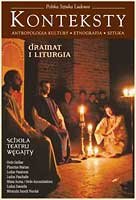Indyjski teatr świątynny i dramat liturgiczny
Indian Temple Theatre and Liturgical Drama
Author(s): Krzysztof Maria Byrski Subject(s): Theatre, Dance, Performing Arts
Published by: Instytut Sztuki Polskiej Akademii Nauk
Keywords: anthropology of the theatre; theology;
Summary/Abstract: The invocation, which preceded my presentation in its last line, calls theatre a sacrifice. What does that mean? Hindus basically have a monistic vision of reality. The entire universe emerged from the One that was at the beginning of time. The most important and characteristic feature of our universe is perception. This is why it is termed – perceptive reality. In order to create such reality the One had to become a perceiving subject and at the same time a perceivable object. It just had to die as the One and had to become many, just for the sake of joy of uniting again. This union can be a joyful experience because the one divides itself also into one who desires and into another one who is desired. While watching this loveable sacrifice for the eyes that theatrical performance is, we emotionally identify ourselves with the process of such unification, follow it and experience the joy of merger into One. The question now has to be answered why can it happen in theatre and why it is so difficult to experience in our daily life? The answer is an emotional distance, which we do not have in our normal life, in which we shun unpleasant experiences and seek only pleasant ones. In theatre we enjoy both of them equally. Why? Because the stage reality is not the proper reality of a hero of a play. It is also not the proper reality of an actor or a spectator. Therefore it is a non-particular reality, which evokes non-particular emotional responses. The Kudiyattam theatre of Kerala by its highly conventionalised form makes it even more striking and by associating it with temple ritual turns theatre into ritual as well.
Journal: Konteksty
- Issue Year: 2007
- Issue No: 02
- Page Range: 136-140
- Page Count: 5
- Language: Polish
- Content File-PDF

